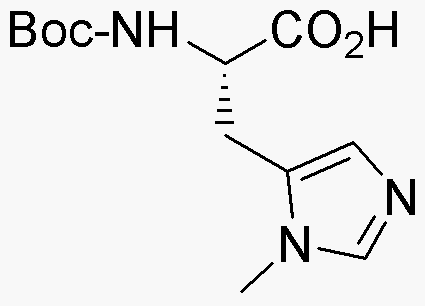Boc-His(3-Me)-OH is widely utilized in research focused on:
- Peptide Synthesis: This compound serves as a key building block in the synthesis of peptides, particularly those that require protected amino acids for stability during chemical reactions.
- Drug Development: It plays a significant role in the pharmaceutical industry for developing peptide-based drugs, enhancing bioactivity and specificity in therapeutic applications.
- Bioconjugation: Researchers use it to create bioconjugates, which are essential in targeted drug delivery systems, improving the efficacy of treatments while minimizing side effects.
- Protein Engineering: The compound aids in modifying proteins to study their functions and interactions, which is crucial for understanding biological processes and developing new biotechnologies.
- Diagnostics: It is also applied in the development of diagnostic tools, such as biosensors, that can detect specific biomolecules, enhancing the accuracy of medical tests.
Informations générales
Propriétés
Sécurité et réglementation
Applications
Boc-His(3-Me)-OH is widely utilized in research focused on:
- Peptide Synthesis: This compound serves as a key building block in the synthesis of peptides, particularly those that require protected amino acids for stability during chemical reactions.
- Drug Development: It plays a significant role in the pharmaceutical industry for developing peptide-based drugs, enhancing bioactivity and specificity in therapeutic applications.
- Bioconjugation: Researchers use it to create bioconjugates, which are essential in targeted drug delivery systems, improving the efficacy of treatments while minimizing side effects.
- Protein Engineering: The compound aids in modifying proteins to study their functions and interactions, which is crucial for understanding biological processes and developing new biotechnologies.
- Diagnostics: It is also applied in the development of diagnostic tools, such as biosensors, that can detect specific biomolecules, enhancing the accuracy of medical tests.
Documents
Fiches de données de sécurité (FDS)
La FDS fournit des informations de sécurité complètes sur la manipulation, le stockage et l’élimination du produit.
Spécifications du produit (PS)
Le PS fournit une description complète des propriétés du produit, notamment sa composition chimique, son état physique, sa pureté et les exigences de stockage. Il détaille également les plages de qualité acceptables et les applications prévues du produit.
Certificats d'analyse (COA)
Recherchez des certificats d'analyse (COA) en saisissant le numéro de lot du produit. Les numéros de lot et de lot se trouvent sur l'étiquette d'un produit, après les mots « Lot » ou « Lot de fabrication ».
Numéro de catalogue
Numéro de lot/série
Certificats d'origine (COO)
Ce certificat d'exploitation confirme le pays dans lequel le produit a été fabriqué, et détaille également les matériaux et composants utilisés et s'il est issu de sources naturelles, synthétiques ou autres sources spécifiques. Ce certificat peut être requis pour les douanes, le commerce et la conformité réglementaire.
Numéro de catalogue
Numéro de lot/série
Fiches de données de sécurité (FDS)
La FDS fournit des informations de sécurité complètes sur la manipulation, le stockage et l’élimination du produit.
DownloadSpécifications du produit (PS)
Le PS fournit une description complète des propriétés du produit, notamment sa composition chimique, son état physique, sa pureté et les exigences de stockage. Il détaille également les plages de qualité acceptables et les applications prévues du produit.
DownloadCertificats d'analyse (COA)
Recherchez des certificats d'analyse (COA) en saisissant le numéro de lot du produit. Les numéros de lot et de lot se trouvent sur l'étiquette d'un produit, après les mots « Lot » ou « Lot de fabrication ».
Numéro de catalogue
Numéro de lot/série
Certificats d'origine (COO)
Ce certificat d'exploitation confirme le pays dans lequel le produit a été fabriqué, et détaille également les matériaux et composants utilisés et s'il est issu de sources naturelles, synthétiques ou autres sources spécifiques. Ce certificat peut être requis pour les douanes, le commerce et la conformité réglementaire.


